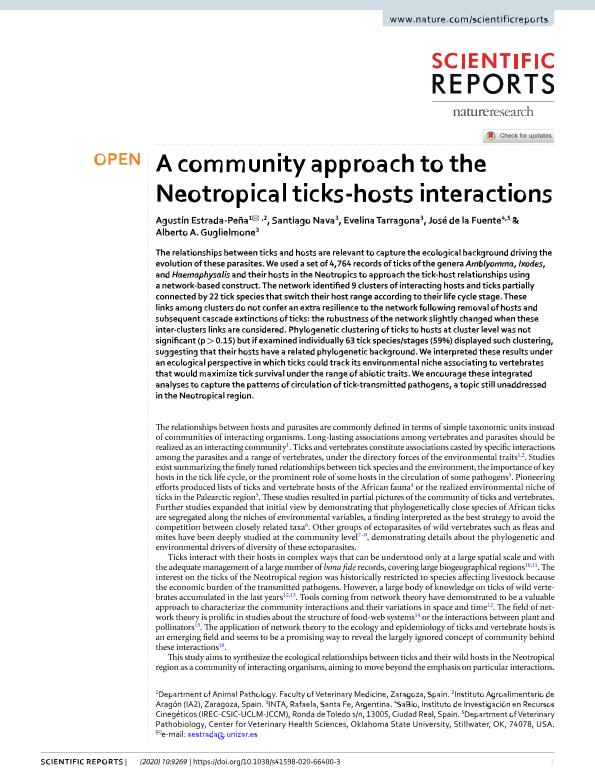Mostrar el registro sencillo del ítem
dc.contributor.author
Estrada Peña, Agustín
dc.contributor.author
Nava, Santiago

dc.contributor.author
Tarragona, Evelina Luisa

dc.contributor.author
de la Fuente, José
dc.contributor.author
Guglielmone, Alberto Alejandro

dc.date.available
2022-02-10T16:02:49Z
dc.date.issued
2020-06
dc.identifier.citation
Estrada Peña, Agustín; Nava, Santiago; Tarragona, Evelina Luisa; de la Fuente, José; Guglielmone, Alberto Alejandro; A community approach to the Neotropical ticks-hosts interactions; Springer; Scientific Reports; 10; 1; 6-2020; 1-9
dc.identifier.issn
2045-2322
dc.identifier.uri
http://hdl.handle.net/11336/151778
dc.description.abstract
The relationships between ticks and hosts are relevant to capture the ecological background driving the evolution of these parasites. We used a set of 4,764 records of ticks of the genera Amblyomma, Ixodes, and Haemaphysalis and their hosts in the Neotropics to approach the tick-host relationships using a network-based construct. The network identified 9 clusters of interacting hosts and ticks partially connected by 22 tick species that switch their host range according to their life cycle stage. These links among clusters do not confer an extra resilience to the network following removal of hosts and subsequent cascade extinctions of ticks: the robustness of the network slightly changed when these inter-clusters links are considered. Phylogenetic clustering of ticks to hosts at cluster level was not significant (p > 0.15) but if examined individually 63 tick species/stages (59%) displayed such clustering, suggesting that their hosts have a related phylogenetic background. We interpreted these results under an ecological perspective in which ticks could track its environmental niche associating to vertebrates that would maximize tick survival under the range of abiotic traits. We encourage these integrated analyses to capture the patterns of circulation of tick-transmitted pathogens, a topic still unaddressed in the Neotropical region.
dc.format
application/pdf
dc.language.iso
eng
dc.publisher
Springer

dc.rights
info:eu-repo/semantics/openAccess
dc.rights.uri
https://creativecommons.org/licenses/by/2.5/ar/
dc.subject
ticks
dc.subject
host
dc.subject
interaction
dc.subject
Neotropical
dc.subject.classification
Otras Ciencias Veterinarias

dc.subject.classification
Ciencias Veterinarias

dc.subject.classification
CIENCIAS AGRÍCOLAS

dc.title
A community approach to the Neotropical ticks-hosts interactions
dc.type
info:eu-repo/semantics/article
dc.type
info:ar-repo/semantics/artículo
dc.type
info:eu-repo/semantics/publishedVersion
dc.date.updated
2021-09-07T14:10:51Z
dc.journal.volume
10
dc.journal.number
1
dc.journal.pagination
1-9
dc.journal.pais
Alemania

dc.description.fil
Fil: Estrada Peña, Agustín. Universidad de Zaragoza; España
dc.description.fil
Fil: Nava, Santiago. Instituto Nacional de Tecnología Agropecuaria. Centro Regional Santa Fe. Estación Experimental Agropecuaria Rafaela; Argentina. Consejo Nacional de Investigaciones Científicas y Técnicas. Centro Científico Tecnológico Conicet - Santa Fe; Argentina
dc.description.fil
Fil: Tarragona, Evelina Luisa. Consejo Nacional de Investigaciones Científicas y Técnicas. Centro Científico Tecnológico Conicet - Santa Fe; Argentina. Instituto Nacional de Tecnología Agropecuaria. Centro Regional Santa Fe. Estación Experimental Agropecuaria Rafaela; Argentina
dc.description.fil
Fil: de la Fuente, José. Oklahoma State University; Estados Unidos
dc.description.fil
Fil: Guglielmone, Alberto Alejandro. Instituto Nacional de Tecnología Agropecuaria. Centro Regional Santa Fe. Estación Experimental Agropecuaria Rafaela; Argentina. Consejo Nacional de Investigaciones Científicas y Técnicas. Centro Científico Tecnológico Conicet - Santa Fe; Argentina
dc.journal.title
Scientific Reports
dc.relation.alternativeid
info:eu-repo/semantics/altIdentifier/url/http://www.nature.com/articles/s41598-020-66400-3
dc.relation.alternativeid
info:eu-repo/semantics/altIdentifier/doi/http://dx.doi.org/10.1038/s41598-020-66400-3
Archivos asociados
